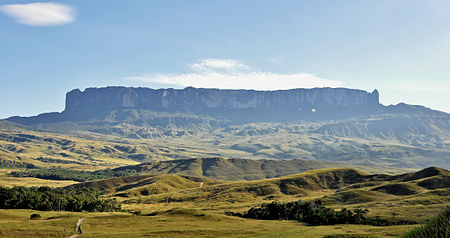Basketball court
| |||||||||||||||||||||||||||||||||||||||||||||||||||||||||||||||||||||||||||||||||||||||||||||||||||||
Read other articles:

烏克蘭總理Прем'єр-міністр України烏克蘭國徽現任杰尼斯·什米加尔自2020年3月4日任命者烏克蘭總統任期總統任命首任維托爾德·福金设立1991年11月后继职位無网站www.kmu.gov.ua/control/en/(英文) 乌克兰 乌克兰政府与政治系列条目 宪法 政府 总统 弗拉基米尔·泽连斯基 總統辦公室 国家安全与国防事务委员会 总统代表(英语:Representatives of the President of Ukraine) 总理…

Keratocytes movement Corneal keratocytes (corneal fibroblasts) are specialized fibroblasts residing in the stroma. This corneal layer, representing about 85-90% of corneal thickness, is built up from highly regular collagenous lamellae and extracellular matrix components. Keratocytes play the major role in keeping it transparent, healing its wounds, and synthesizing its components. In the unperturbed cornea keratocytes stay dormant, coming into action after any kind of injury or inflammation. So…

For other uses, see Real. Commune in Occitania, FranceRéal RalCommuneView of Réal from the Formiguères roadLocation of Réal RéalShow map of FranceRéalShow map of OccitanieCoordinates: 42°37′53″N 2°08′04″E / 42.6314°N 2.1344°E / 42.6314; 2.1344CountryFranceRegionOccitaniaDepartmentPyrénées-OrientalesArrondissementPradesCantonLes Pyrénées catalanesIntercommunalityPyrénées CatalanesGovernment • Mayor (2020–2026) Jean-Luc Seguy[1&…

Tingkat trofi suatu organisme adalah posisi yang mereka tempati pada rantai makanan. Sebuah rangkai makanan adalah sebuah suksesi organisme yang memakan organisme lainnya, yang barangkali akan dimakan organisme lainnya. Tingkat trofi merujuk kepada jumlah tahapan dari awal rantai makanan. Sebah rantai makanan dimulai dari tingkat satu dengan produsen primer seperti tumbuhan, lalu berlanjut ke herbivor pada tingkat kedua, karnivor apda tingkat tiga atau lebih, dan umumnya berakhir pada predator p…

لمعانٍ أخرى، طالع قائمة الدول حسب الناتج المحلي الإجمالي (توضيح). تتضمن هذه المقالة ثلاث قوائم لبلدان العالم مرتبة حسب ناتجها المحلي الإجمالي للفرد الواحد في القيم الاسمية، وتضم القيمة النهائية لجميع السلع والخدمات المنتجة داخل الدولة في سنة معينة وتحويلها بأسعار ال…

Gunung RoraimaGunung RoraimaTitik tertinggiKetinggian2.810 m (9.220 ft)[1]Puncak2.338 m (7.671 ft)[1]Masuk dalam daftarCountry high pointUltra prominent peakGeografiGunung RoraimaLokasi di wilayah Venezuela (di perbatasan antara Guyana dan Brazil)LetakVenezuela/Brasil/GuyanaPegununganDataran tinggi GuyanaGeologiJenis gunungPlateauPendakianPendakian pertama1884, dipimpin oleh Sir Everard im Thurn bersama Harry Inniss Perkins dan beberapa orang penduduk lokal gu…

Arijit SinghArijit Singh di Penghargaan GiMA ke-5 2015Lahir25 April 1987 (umur 37)[1]Jiaganj, Murshidabad, Bengal BaratKebangsaanIndiaPekerjaan Penyanyi komponis musik[2] Programmer musik Produser musik Produser rekaman[3] Pementas panggung[4] Suami/istriKoyel Roy (2014)[5]Anak2Karier musikGenre Vokal playback filmi pop EDM[6] Ghazal Klasik India[7] Instrumen Vokal gitar piano tabla Situs web Arijit Singh di Facebook Arijit Singh adala…

أقبالية رقم ۱ اقباليه شماره 1 - قرية - تقسيم إداري البلد إيران المحافظة أصفهان المقاطعة آران وبيدغل الناحية Central القسم الريفي قسم سفید دشت الريفي إحداثيات 34°02′28″N 51°25′51″E / 34.04111°N 51.43083°E / 34.04111; 51.43083 السكان معلومات أخرى التوقيت توقيت إيران (+3:30 غرين�…

Mustapha MoussaM. Moussa dengan E. HolyfieldStatistikNama asliMustapha MoussaDinilai padaKelas berat ringanKebangsaanAljazairLahir2 Februari 1962 (umur 62)Oran Mustapha Moussa (Arab: مصطفى موسى; lahir 2 Februari 1962) adalah seorang mantan petinju Aljazair yang berlomba dalam divisi kelas berat ringan. Ia memenangkan medali Olimpiade pertama untuk Aljazair, memenangkan medali perunggu di Olimpiade Musim Panas 1984 di Los Angeles.[1] Ia berbagi podium dengan petinju Amer…

You can help expand this article with text translated from the corresponding article in Spanish. (September 2020) Click [show] for important translation instructions. View a machine-translated version of the Spanish article. Machine translation, like DeepL or Google Translate, is a useful starting point for translations, but translators must revise errors as necessary and confirm that the translation is accurate, rather than simply copy-pasting machine-translated text into the English Wikip…

American philosopher Richard L. VelkleyBorn (1949-03-17) March 17, 1949 (age 75)EducationCornell University (A.B)Pennsylvania State University (Ph.D.)AwardsNEH FellowshipEarhart Foundation FellowshipBradley Foundation FellowshipACLS FellowshipEra21st-century philosophyRegionWestern philosophySchoolContinentalInstitutionsTulane UniversityThesisKant as Philosopher of Theodicy (1978)Doctoral advisorThomas SeebohmMain interestspolitical philosophy, post-Kantian philosophy Websiteliberalart…

1920 lightvessel, now a museum ship in Port Huron, Michigan, United States LV-103 circa 1922 History United States NameLV-103 BuilderConsolidated Shipbuilding Co Laid downJune 5, 1918 LaunchedMay 1, 1920 In serviceDecember 22, 1920 Out of serviceAugust 25, 1970 StatusMuseum Ship General characteristics Displacement312 tons Length97 ft (30 m) Beam24 ft (7.3 m) Draft9 ft 6 in (2.90 m) Propulsion175 hp steam engine (original equipment) Speed8 knots (15 km/h; …

Halaman ini berisi artikel tentang keseluruhan seri permainan video. Untuk kegunaan lain, lihat Castlevania (disambiguasi). CastlevaniaLogo seri permainan Castlevania.Genrepermainan aksi-petualanganPengembang KonamiRilis pertamaCastlevania26 September 1986Rilis terakhirCastlevania: The Adventure ReBirth27 October 2009Situs webKonami TokyoKonami Amerika Castlevania adalah sebuah serial permainan video yang diciptakan dan dikembangkan oleh Konami. Serial ini memulai debutnya di Jepang pada tanggal…

Part of the Vietnam and Cambodian Civil Wars (1970–1973) Operation Freedom DealPart of the Cambodian Civil War and the Vietnam WarLocationCambodiaCommanded by Richard M. Nixon Henry KissingerDate19 May 1970 – 15 August 1973Executed bySeventh Air ForceOutcome In U.S., adoption of the War Powers Resolution Delaying the fall of the capital Phnom Penh to the Khmer Rouge Accelerated collapse of rural Cambodian society, displacement of tens of thousands from countryside to city, increase…

Ideal Collegeআইডিয়াল কলেজTypePrivate collegeEstablished1969 (1969)[1]ChairmanSyed Rezaur Rahman[2]PrincipalMobaswer HossainAcademic staff114[3]Address65 Central Road, Dhanmondi[1], Dhaka, 1205, BangladeshCampusUrbanLanguageBengali mediumEIIN107971[4]ColorsWhite, Black and Sky[3] Websitewww.idealcollegedhanmondi.edu.bd Ideal College (Bengali: আইডিয়াল কলেজ), also known as Ideal…

Declaración de Independencia de los Estados Unidos Facsímil de la versión manuscrita (1823).[a]Idioma inglésFunción declarar la independencia de las Trece Colonias con respecto del Reino de Gran Bretaña[4]Autor(es) Thomas Jefferson et al.(copia a mano: Timothy Matlack, probablemente)[5]Creación junio a julio de 1776Ratificación 4 de julio de 1776 (247 años)Signatario(s) 56 delegados del Congreso ContinentalUbicación versión manuscrita: Archivos Nacionalesborr…

American magazine Confederate VeteranConfederate Veteran, cover dated May 1893EditorFrank B. Powell IIIFormer editorsS. A. CunninghamEdith D. PopeFrequencyBimonthlyFounderS. A. CunninghamFounded1893Final issueStill in printLanguageEnglishOCLC1564663 The Confederate Veteran was a magazine about veterans of the Confederate States Army during the American Civil War of 1861–1865, propagating the myth of the Lost Cause of the Confederacy. It was instrumental in popularizing the legend of Sam Davis.…

Зміст 1 Анотаційні дошки і пам'ятні знаки 2 Меморіальні дошки 2.1 На честь людей 2.2 На честь подій 3 Демонтовані дошки 4 Примітки 5 Джерела 6 Див. також Анотаційні дошки і пам'ятні знаки Зображення На честь кого, чого чи якої події Адреса Дата встановлення Вулицю названо на честь …

Penyuntingan Artikel oleh pengguna baru atau anonim untuk saat ini tidak diizinkan.Lihat kebijakan pelindungan dan log pelindungan untuk informasi selengkapnya. Jika Anda tidak dapat menyunting Artikel ini dan Anda ingin melakukannya, Anda dapat memohon permintaan penyuntingan, diskusikan perubahan yang ingin dilakukan di halaman pembicaraan, memohon untuk melepaskan pelindungan, masuk, atau buatlah sebuah akun. Pokémon Logo Pokémon versi internasional.PengarangSatoshi TajiriJudul asliPoc…

Questa voce sull'argomento calciatori emiratini è solo un abbozzo. Contribuisci a migliorarla secondo le convenzioni di Wikipedia. Segui i suggerimenti del progetto di riferimento. Mohamed Obaid Al-ZahiriNazionalità Emirati Arabi Uniti Calcio RuoloDifensore CarrieraSquadre di club1 1997-2000 Al-Ain? (?) Nazionale 1984-2000 Emirati Arabi Uniti53 (4) 1 I due numeri indicano le presenze e le reti segnate, per le sole partite di campionato.Il simbolo → indica un trasferimento in p…




